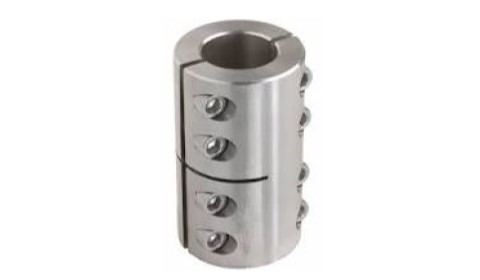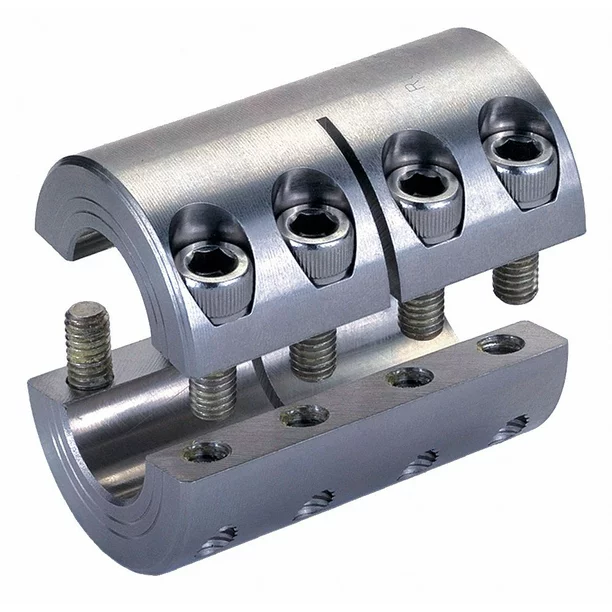Product Description
Single-Section Stainless Steel Pipe Coupling
1. Briefs :
* Mainly used for varied pipe connection
* Suit for Water, Sewage, Gas, Oil Service Pipeline .
2. Features :
* used for both pipe connection and leaking pipe repair
* allow angular deflection
* anticorrosive
* easy installation and dismantle
3. Dimension Sheet
| S/N | O. D Range | Ship | Industry | Length (mm) | |
| mm | PN (bar) | WP (bar) | Normal | Extended | |
| 1 | 21-23 | 16 | 32 | 57 | |
| 2 | 26-28 | 16 | 32 | 57 | |
| 3 | 33-35 | 16 | 32 | 57 | |
| 4 | 42-44 | 16 | 32 | 57 | |
| 5 | 47-49 | 16 | 32 | 57 | 100 |
| 6 | 56-58 | 16 | 32 | 57 | 100 |
| 7 | 59-62 | 16 | 32 | 80 | 139 |
| 8 | 62-64 | 16 | 32 | 80 | 139 |
| 9 | 75-78 | 14 | 28 | 80 | 139 |
| 10 | 79-81 | 14 | 28 | 80 | 203 |
| 11 | 88-92 | 14 | 28 | 107 | 203 |
| 12 | 106-110 | 14 | 28 | 107 | 203 |
| 13 | 112-116 | 14 | 28 | 107 | 203 |
| 14 | 116-119 | 14 | 28 | 107 | 203 |
| 15 | 123-126 | 14 | 28 | 107 | 203 |
| 16 | 131-134 | 14 | 28 | 107 | 203 |
| 17 | 137-143 | 14 | 28 | 116 | 203 |
| 18 | 157-161 | 12 | 24 | 116 | 203 |
| 19 | 163-166 | 12 | 24 | 116 | 203 |
| 20 | 166-170 | 12 | 24 | 116 | 203 |
| 21 | 168-172 | 12 | 24 | 116 | 203 |
| 22 | 198-201 | 8 | 16 | 155 | 255 |
| 23 | 217-221 | 8 | 16 | 155 | 255 |
| 24 | 250-254 | 8 | 16 | 155 | 255 |
| 25 | 271-275 | 8 | 16 | 155 | 255 |
| 26 | 313-317 | 7 | 14 | 155 | 255 |
| 27 | 323-327 | 7 | 14 | 155 | 255 |
| 28 | 354-358 | 7 | 14 | 155 | 255 |
| 29 | 375-379 | 7 | 14 | 155 | 255 |
Note: we accept your specific dimensions which are not included in the above list .
4. Rubber Sealing Sleeve Material
| Rubber Sealing Sleeve Material Chart | |
| Material | Suit for |
| EPDM | Temperature Range : -20ºC to +120ºC Suit for water, waster water, air, CHINAMFG and chemicals fluids |
| NBR | Temperature Range : -20ºC to +120ºC Suit for gas,oil, crude oil and other hydrocarbon fluids |
| MVQ(Silicon Rubber) | Temperatuer Range: -75ºC to +200ºC sunlight resistant, heat resistant, high temperature isolation |
| VITON( Fluoro Rubber) | Temperature Range: -95ºC to +300ºC heat resistant, chemical attack resistant |
Note: you should choose the kind of rubber material based on the type of fluids of your pipeline .
/* January 22, 2571 19:08:37 */!function(){function s(e,r){var a,o={};try{e&&e.split(“,”).forEach(function(e,t){e&&(a=e.match(/(.*?):(.*)$/))&&1
Are There Any Safety Considerations When Using Clamp Couplings in Specific Applications?
While clamp couplings are generally considered safe and reliable, there are specific safety considerations to keep in mind when using them in various applications:
- Proper Installation: Ensuring the clamp coupling is installed correctly is crucial for its safe operation. Follow the manufacturer’s guidelines and torque specifications during installation to prevent coupling failure.
- Maintenance: Regular maintenance is essential to identify wear, corrosion, or damage that could compromise the coupling’s integrity. Replace worn or damaged parts promptly to prevent unexpected failures.
- Temperature and Environment: Consider the operating temperature and environmental conditions of the application. In high-temperature or corrosive environments, choose materials like stainless steel that can withstand such conditions without compromising safety.
- Alignment: Misalignment between shafts can lead to premature wear and coupling failure. Ensure the shafts are properly aligned to prevent excessive stress on the coupling.
- Overloading: Avoid exceeding the torque and speed limits specified by the manufacturer. Overloading the coupling can lead to premature failure and safety hazards.
- Dynamic Balancing: In rotating machinery, ensure that components are dynamically balanced to reduce vibrations that could affect the coupling’s performance and cause fatigue failure.
- Periodic Inspection: Regularly inspect the clamp coupling and surrounding components for signs of wear, fatigue, or damage. Address any issues promptly to prevent unexpected failures.
- Application-Specific Considerations: Consider the specific requirements of the application. For example, in food processing, choose couplings that meet hygienic standards, while in explosive environments, consider couplings with anti-spark features.
- Training and Awareness: Ensure that personnel working with clamp couplings are adequately trained and aware of safety guidelines to handle the equipment properly.
By adhering to these safety considerations and taking appropriate precautions, clamp couplings can be used safely and effectively in various applications, contributing to the reliability and efficiency of mechanical systems.
Potential Causes of Failure in Clamp Couplings and Prevention
While clamp couplings are robust and reliable, certain factors can lead to failure if not addressed properly. Here are some potential causes of failure and the corresponding prevention measures:
- Insufficient Torque: If the coupling is not tightened to the recommended torque, it may slip or come loose during operation. To prevent this, always follow the manufacturer’s torque specifications and use a torque wrench during installation.
- Material Fatigue: Repeated load cycles and excessive vibration can lead to material fatigue and eventual failure. Choosing high-quality materials and performing regular inspections can help detect fatigue and replace the coupling before failure occurs.
- Corrosion: In corrosive environments, the coupling’s material may degrade over time, compromising its strength. Using stainless steel or other corrosion-resistant materials can prevent this issue.
- Improper Alignment: Misalignment between shafts can put undue stress on the coupling, leading to premature failure. Properly align the shafts during installation to avoid this problem.
- Overloading: Exceeding the maximum torque or speed limits specified by the manufacturer can cause the coupling to fail. Stay within the recommended operating parameters to prevent overloading.
- Temperature Extremes: Extreme temperatures can affect the material properties and cause the coupling to become brittle or lose its integrity. Select a coupling rated for the operating temperature range of the application.
- Poor Maintenance: Neglecting regular maintenance can lead to undetected wear, damage, or contamination, which may ultimately result in failure. Implement a proactive maintenance schedule and inspect the coupling regularly.
- Foreign Object Debris (FOD): Foreign particles or debris caught between the coupling components can lead to uneven loads and wear. Keep the coupling and its surroundings clean to avoid FOD-related issues.
- Improper Installation: Incorrectly installing the coupling, such as using incorrect fasteners or not following the manufacturer’s guidelines, can compromise its performance and durability. Always refer to the installation instructions and seek professional help if needed.
- Environmental Factors: Consider the specific environmental conditions of the application, such as humidity, chemicals, or abrasive substances, and select a coupling that can withstand these conditions.
By understanding and addressing these potential causes of failure, users can ensure the longevity and reliable performance of clamp couplings in their mechanical systems.
What is a Clamp Coupling and How Does it Work?
A clamp coupling is a type of mechanical coupling used to connect two shafts together to transmit torque and rotational motion between them. It is a simple and effective way of joining shafts in various mechanical systems. The main components of a clamp coupling typically include two hubs and a center section.
Working Principle:
The clamp coupling works on the principle of frictional force and mechanical interference fit. Here’s how it functions:
- Hub Assembly: Each end of the shaft has a hub, which is a cylindrical component with a bored hole that matches the shaft diameter. The hubs may have keyways or splines to provide additional torque transmission.
- Center Section: The center section of the coupling sits between the two hubs. It is often a split cylindrical sleeve with threaded holes on its outer surface.
- Clamping: To assemble the clamp coupling, the two hubs are placed on the respective shafts, and the center section is inserted between them. Then, bolts are inserted through the holes in the hubs and screwed into the threaded holes of the center section. As the bolts are tightened, the center section is drawn inward, creating a compressive force on the shafts and the hubs, thus firmly holding them together.
- Frictional Connection: The clamping force between the center section and the shafts creates a frictional connection. This frictional force allows the coupling to transmit torque and rotational motion from one shaft to the other.
Advantages:
Clamp couplings offer several advantages:
- Easy and quick installation, requiring minimal tools and no special skills.
- Simple design and cost-effective manufacturing.
- High torque transmission capacity, making them suitable for various industrial applications.
- Zero backlash, ensuring accurate and precise motion transfer.
- Can accommodate different shaft sizes and materials, providing flexibility in design.
Applications:
Clamp couplings find application in a wide range of industries and mechanical systems, including:
- Power transmission in industrial machinery and equipment.
- Robotics and automation systems.
- Printing and packaging machines.
- Material handling equipment.
- Pumps and compressors.
- Conveyor systems.
Overall, clamp couplings are a reliable and versatile solution for connecting rotating shafts and transferring power in various mechanical setups.
editor by CX 2024-04-29




